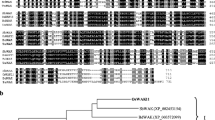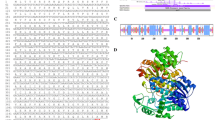Abstract
The expression of the Arabidopsis heat shock protein (HSP) 18.2 promoter-β-d-glucuronidase (GUS) chimera gene was investigated in transgenic Nicotiana plumbaginifolia plants during the recovery phase at normal temperatures (20–22 °C) after a heat shock (HS) treatment. GUS activity increased during the recovery phase after HS at 42 °C for 2 h, and maximal GUS activity was observed after 12 h at normal temperatures, at levels 50–100 times higher than the activity immediately after HS. After HS at 44 °C, little GUS activity was observed during the first 20–24 h at normal temperatures, but the activity increased gradually thereafter, to reach a maximum at 40–50 h. After HS at 45 °C, no GUS activity was observed throughout the experimental period. RT-PCR analysis showed that GUS mRNA remained for 10 h after a 2-h HS at 42 °C and for 40 h after a 2-h HS at 44 °C. These findings demonstrate that brief HS treatment, especially at a sublethal temperature, induces a long-term accumulation of HSP-GUS mRNA during the recovery phase.
Similar content being viewed by others
Author information
Authors and Affiliations
Additional information
Received: 31 July 1998 / Revision received: 4 November 1998 / Accepted: 19 February 1999
Rights and permissions
About this article
Cite this article
Moriwaki, M., Yamakawa, T., Washino, T. et al. Delayed recovery of β-glucuronidase activity driven by an Arabidopsis heat shock promoter in heat-stressed transgenic Nicotiana plumbaginifolia. Plant Cell Reports 19, 96–100 (1999). https://doi.org/10.1007/s002990050717
Issue Date:
DOI: https://doi.org/10.1007/s002990050717




